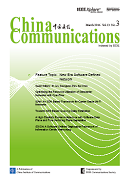FEATURE TOPIC: NEW ERA SOFTWARE DEFINED NETWORK
GAO Xianming, WANG Baosheng, ZHANG Xiaozhe, MA Shicong
2016, 13(3): 37-52.
Routers have traditionally been architected as two elements: forwarding plane and control plane through ForCES or other protocols. Each forwarding plane aggregates a fixed amount of computing, memory, and network interface resources to forward packets. Unfortunately, the tight coupling of packet-processing tasks with network interfaces has severely restricted service innovation and hardware upgrade. In this context, we explore the insightful prospect of functional separation in forwarding plane to propose a next-generation router architecture, which, if realized, can provide promises both for various packet-processing tasks and for flexible deployment while solving concerns related to the above problems. Thus, we put forward an alternative construction in which functional resources within a forwarding plane are disaggregated. A forwarding plane is instead separated into two planes: software data plane (SDP) and flow switching plane (FSP), and each plane can be viewed as a collection of "building blocks". SDP is responsible for packet-processing tasks without its expansibility restricted with the amount and kinds of network interfaces. FSP is in charge of packet receiving/transmitting tasks and can incrementally add switching elements, such as general switches, or even specialized switches, to provide network interfaces for SDP. Besides, our proposed router architecture uses network fabrics to achieve the best connectivity among building blocks, which can support for network topology reconfiguration within one device. At last, we make an experiment on our platform in terms of bandwidth utilization rate, configuration delay, system throughput and execution time.
